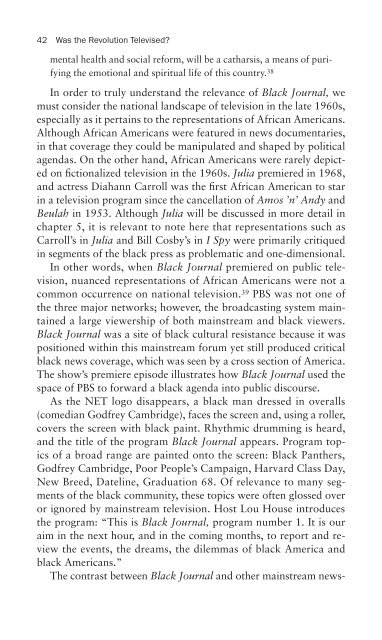Revolution Televised.pdf
Revolution Televised.pdf
Revolution Televised.pdf
You also want an ePaper? Increase the reach of your titles
YUMPU automatically turns print PDFs into web optimized ePapers that Google loves.
42 Was the <strong>Revolution</strong> <strong>Televised</strong>?<br />
mental health and social reform, will be a catharsis, a means of purifying<br />
the emotional and spiritual life of this country. 38<br />
In order to truly understand the relevance of Black Journal, we<br />
must consider the national landscape of television in the late 1960s,<br />
especially as it pertains to the representations of African Americans.<br />
Although African Americans were featured in news documentaries,<br />
in that coverage they could be manipulated and shaped by political<br />
agendas. On the other hand, African Americans were rarely depicted<br />
on fictionalized television in the 1960s. Julia premiered in 1968,<br />
and actress Diahann Carroll was the first African American to star<br />
in a television program since the cancellation of Amos ’n’ Andy and<br />
Beulah in 1953. Although Julia will be discussed in more detail in<br />
chapter 5, it is relevant to note here that representations such as<br />
Carroll’s in Julia and Bill Cosby’s in I Spy were primarily critiqued<br />
in segments of the black press as problematic and one-dimensional.<br />
In other words, when Black Journal premiered on public television,<br />
nuanced representations of African Americans were not a<br />
common occurrence on national television. 39 PBS was not one of<br />
the three major networks; however, the broadcasting system maintained<br />
a large viewership of both mainstream and black viewers.<br />
Black Journal was a site of black cultural resistance because it was<br />
positioned within this mainstream forum yet still produced critical<br />
black news coverage, which was seen by a cross section of America.<br />
The show’s premiere episode illustrates how Black Journal used the<br />
space of PBS to forward a black agenda into public discourse.<br />
As the NET logo disappears, a black man dressed in overalls<br />
(comedian Godfrey Cambridge), faces the screen and, using a roller,<br />
covers the screen with black paint. Rhythmic drumming is heard,<br />
and the title of the program Black Journal appears. Program topics<br />
of a broad range are painted onto the screen: Black Panthers,<br />
Godfrey Cambridge, Poor People’s Campaign, Harvard Class Day,<br />
New Breed, Dateline, Graduation 68. Of relevance to many segments<br />
of the black community, these topics were often glossed over<br />
or ignored by mainstream television. Host Lou House introduces<br />
the program: “This is Black Journal, program number 1. It is our<br />
aim in the next hour, and in the coming months, to report and review<br />
the events, the dreams, the dilemmas of black America and<br />
black Americans.”<br />
The contrast between Black Journal and other mainstream news-

















